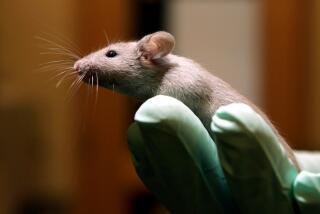Study Tallies 435 U.S. Radiation Tests on Humans : Experiments: Some of the 16,000 subjects in the decades-long research did not know the health risks or give their consent, energy officials say.
- Share via
WASHINGTON — The Energy Department has concluded that it or its predecessors conducted 435 documented radiation experiments between World War II and the mid-1970s on some 16,000 people, some of whom did not know the health risks or even give their consent.
But while some of the tests were ethically questionable, the research contributed enormously to the foundations of modern medical science, Energy Secretary Hazel O’Leary said Thursday.
Many of the experiments were conducted “to go after breakthroughs on the medical front,” O’Leary told reporters.
Tara O’Toole, an assistant energy secretary, said that while the research “raises ethical questions, it’s also really quite a heroic and amazing story of progress.”
The experiments were instrumental in diagnosing and treating thyroid problems, cancer, heart disease and other conditions, O’Toole said.
O’Leary said there was a “dark side” to the radiation research: Some of the experiments, shrouded in secrecy for decades, were conducted on subjects without their full understanding or on vulnerable populations such as children and prisoners.
“The culture of secrecy was deeply embedded” in her department and its predecessor agencies, including the Atomic Energy Commission, she said.
Ellyn Weiss, director of the department’s Office of Human Radiation Experiments, said the available documents left unclear the extent of subject consent. She said there is no way to know the full impact of the experiments on the 16,000 individuals, because in many cases the department doesn’t even know the names of the individuals.
*
A presidential commission in September is expected to report on the more controversial aspects of the experiments, including the government’s role in setting standards for tests on humans, and the use of very high doses of radiation in some cases, particularly on terminally ill patients.
Chapters of a draft of the commission’s findings, obtained by The Times on Thursday, shows that medical experts were fully aware of the ethical concerns over the decades.
For example, twice in 1947, the general manager of the AEC wrote to Stafford Warren, a scientist on the medical research team for the Manhattan Project, which developed the atomic bomb, telling him that clinical testing should go forward only if there is a prospect that the patient could benefit medically and after the patient consented to the test.
But there is little evidence that the directive was followed at some prominent institutions. Patients were routinely left in the dark, Dan Guttman, executive director of the commission, said in an interview Thursday.
Guttman and others on the commission stressed that the government, medical professionals and others involved in the tests were acutely concerned about the risk that subjects faced “but [showed] less concern for telling the people of the risks.”
In the cases where the subjects did not stand to benefit from the exposure, only very small doses were administered, he said. However, the same was not true when patients were judged to possibly benefit from radiation treatment. In those instances, he said, questions arise about whether patients were fully apprised of the risks.
*
The government, trying to gauge the effects of radiation on military personnel in the event of a nuclear blast, paid research institutes for information about the results of heavy doses of radiation on patients.
Commission members said in interviews Thursday that they were pleased the research had not found any new examples of the government putting Americans at grave risk.
“Prior to the advisory committee being instituted, there were people in the country concerned that there were dark secrets that people didn’t know about,” said panel member Henry Royal, associate director of the division of nuclear medicine at Washington University School of Medicine in St. Louis.
“Despite an intense effort, we really have not come up with any unexpected shocking thing. . . ,” he said.
In addition to collecting documentation on the human experiments, the Energy Department review also uncovered evidence that intentional releases of radiation by the government into the environment were many times more frequent than disclosed previously.
A 1993 General Accounting Office report found only 13 such incidents nationwide. There is now evidence of 50 to 60 radiation releases involving testing of radiological weapons and another 250 incidents of releases at New Mexico’s Los Alamos Scientific Laboratory alone.
“The risks were very low, but the secrecy was there,” Guttman said. “When things were done in secret, people in the community say: ‘How can I know what I can trust?’ ”
More to Read
Sign up for Essential California
The most important California stories and recommendations in your inbox every morning.
You may occasionally receive promotional content from the Los Angeles Times.













